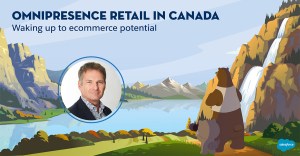It was during a conversation for his last book with Bridget Dolan, the vice-president of innovation at beauty giant Sephora, that helped Doug Stephens understand how successful retailers make the most of new digital channels as they emerge.
“I asked her, do they become preoccupied with big shiny objects like Instagram once they become popular?” Stephens, a retail futurist and founder of the consultancy Retail Prophet, is widely known for his ability to see future industry trends, recalled in conversation with the Salesforce Canada blog ahead of his recent webinar. “Her answer was that, no, they focus instead on the customer’s problems and how they can leverage something like Instagram to make the shopping experience better. Technology is the answer but the key is understanding the problem”
While Sephora could have simply started posting its latest products to Instagram, for instance, Stephens said the company looked at it another way: when you’re standing in a store with more than 1,000 shades of lipstick, how can you winnow your choices down to your top five picks?
Stephens suggests merchants need to apply much more of that thinking in his recently published Salesforce eBook, Waking The Sleeping Giant: Omnipresence Retail In Canada. While many shops are still struggling to master omni-channel retailing — where they are at least present and available across a myriad of digital touchpoints — Stephens explains in the eBook how omnipresence involves developing true communities, where they use technologies like artificial intelligence to predict and shape the best possible customer experiences.
“I would love to say the majority (of retailers) are proactive, taking their destiny into their own hands and are tying to reengineer themselves or disrupt themselves. The reality is, they often wait until the threat lands on their doorstep,” says Stephens, referring to the rise of digital-first firms that bring new or increased competition. “The unfortunate part about that is by the time they realize they’re being threatened, sales are spiraling downward, capital expenses are getting cut and so the innovations they need become things they can’t afford.”
Why Retailers Need a Data Strategy
Of course, companies with a long history in physical retail may not be sure where to begin. Stephens suggests first looking at the sophisticated way in which large online retailers like Amazon are collecting customer data — not only from web visits but new touchpoints such as smart speakers — to drive their strategy.
“You don’t necessarily need to get robust data from every single customer,” he says. “What you do need to know is, who are your most engaged consumers and what could you offer in the way of elevated value or experience that makes them far more willing to share data with you?”
Many retailers have tried to get at this through some kind of loyalty program, but Stephens challenges them with this question: if customers were asked to pay to be part of such programs, would they really see the value? If the answer is no, you have to go back to the value you’re offering in exchange for data. “I’m actually more a fan of paid membership and the promise of subscription-style services,” he said.
Mapping the Journey, and Managing it with Media
As the data comes in, the next step is developing a more holistic view of the current customer experience — not what they’re experiencing by their tenth purchase, Stephens cautions, but from the very first interaction onwards.
“It’s not an easy process. It needs to be very detailed for every moment and micro-moment,” he says. “Once it’s done, you step back and ask, ‘Where are the points of friction in this journey? Where are the moments that are under-capitalized? Where does the shopper need more information or to touch a product to be comfortable with making a purchase?’”
One way to act more like a valued companion on those journeys is to recognize the way digital and physical experiences complement each other, Stephens added. Technology has had a profound impact on the way we communicate for example, particularly through mobile tools like smartphones, mobile websites and apps.
“Media once drove us to a source, but now stores are an incredibly effective way to bring branded media and physical media to consumers. The two have reversed roles,” he says. “Retailers should make sure every piece of media they put into the market is a direct portal to purchase. We need to facilitate that ability for the consumer to buy immediately.”
Choose The Right Retail Innovation Metrics
Omnipresence will inevitably require some trial and error, and Stephens suggests retailers’ efforts shouldn’t always be evaluated simply by sales volumes.
“I’d look at things like, ‘What percentage of initiatives are actually born out of innovation?’ In other words, not just improving a product or addressing a packaging upgrade but things that are completely new — new processes, new services, new revenue channels,” he says. “On the output side, how many patents did we file for, how many licenses did we create, how many trademarks? How much of our capital investments were spent on innovative projects? The market and investors put retailers in a position where they feel they can’t afford to miss their top or bottom line numbers. Unfortunately, those metrics and true innovation don’t necessarily always go hand in hand.”
Learn about Doug Stephens’ outlook on the Canadian retail sector, the replenishment economy and how omnipresence can ensure long-term survival by downloading the eBook, Waking The Sleeping Giant, from Salesforce.

























